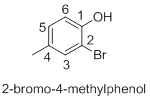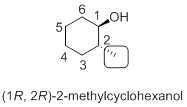
(a)
Interpretation:
The structure of the given compound should be drawn.
Concept introduction:
(a)
Answer to Problem 27PP
The IUPAC name of the given organic compound is 2-propyl-1-pentanol.
Explanation of Solution
To find: IUPAC name of the compound
The IUPAC name of the given organic compound is 2-propyl-1-pentanol which is shown here.


Identify the parent chain of the compound. Here the hydroxyl group which is attached to the carbon is included as a parent. Given the numbers for the carbon atom in a long chain (parent chain), so parent chain having five carbon atoms is called as pentanol. There is a side chain which indicated above in the structure. There are three carbons in the side chain which is attached on C2 carbon atom. The IUPAC name of the given organic compound is 2-propyl-1-pentanol.
Conclusion
The IUPAC name of the given organic compound is found.
(b)
Interpretation:
The structure of the given compound should be drawn.
Concept introduction:
IUPAC nomenclature: A systematic method of naming organic chemical compounds is called as IUPAC nomenclature of organic chemistry.
(b)
Answer to Problem 27PP
The IUPAC name of the given organic compound is (R)-4-methyl-2-pentanol.
Explanation of Solution
To find: IUPAC name of the compound
The IUPAC name of the given organic compound is (R)-4-methyl-2-pentanol which is shown here.


Identify the parent chain of the compound. Here the hydroxyl group which is attached to the carbon is included in the parent. Given the numbers for the carbon atom in a long chain (parent chain), so parent chain having five carbon atoms is called as pentanol. There is a side chain which indicated above in the structure. There is one carbon in the side chain which is attached on C4 carbon atom and assigns the configuration for the chiral center. The IUPAC name of the given organic compound is (R)-4-methyl-2-pentanol.
Conclusion
The IUPAC name of the given organic compound is found.
(c)
Interpretation:
The structure of the given compound should be drawn.
Concept introduction:
IUPAC nomenclature: A systematic method of naming organic chemical compounds is called as IUPAC nomenclature of organic chemistry.
(c)
Answer to Problem 27PP
The IUPAC name of the given organic compound is 2-bromo-4-methylphenol.
Explanation of Solution
To find: IUPAC name of the compound
The IUPAC name of the given organic compound is 2-bromo-4-methylphenol which is shown here.


Identify the parent of the compound. Here the phenol is the parent compound. The numbering is started in carbon atom which is bearing hydroxyl group in the given structure. There is two substituent (bromo and methyl) are attached on the ring and indicated in above structure. Bromine atom is attached on C2 carbon atom and methyl group is attached on C4 carbon atom of the phenyl ring. The IUPAC was given according to the alphabetical manner. Therefore, The IUPAC name of the given organic compound is 2-bromo-4-methylphenol.
Conclusion
The IUPAC name of the given organic compound is found.
(d)
Interpretation:
The structure of the given compound should be drawn.
Concept introduction:
IUPAC nomenclature: A systematic method of naming organic chemical compounds is called as IUPAC nomenclature of organic chemistry.
(d)
Answer to Problem 27PP
The IUPAC name of the given organic compound is (1R, 2R)-2-methylcyclohexanol.
Explanation of Solution
To find: IUPAC name of the compound
The IUPAC name of the given organic compound is (1R, 2R)-2-methylcyclohexanol which is shown here.

Identify the parent chain of the compound. The hydroxyl group which is attached to the carbon is included in the parent. Given the numbers for the carbon atoms in cyclic chain (numbers starts from carbon atom which is bearing hydroxyl group) and cyclic chain having six carbon atoms therefore called as cyclohexanol. There is only one substituent (methyl group) attached on the ring and indicated in above structure. Numbering the carbon atom in a clockwise direction and assigns the configuration for the chiral center. Therefore, the IUPAC name of the given organic compound is (1R, 2R)-2-methylcyclohexanol.
Conclusion
The IUPAC name of the given organic compound is found.
Want to see more full solutions like this?
Chapter 12 Solutions
Organic Chemistry
- + C8H16O2 (Fatty acid) + 11 02 → 8 CO2 a. Which of the above are the reactants? b. Which of the above are the products? H2o CO₂ c. Which reactant is the electron donor? Futty acid d. Which reactant is the electron acceptor? e. Which of the product is now reduced? f. Which of the products is now oxidized? 02 #20 102 8 H₂O g. Where was the carbon initially in this chemical reaction and where is it now that it is finished? 2 h. Where were the electrons initially in this chemical reaction and where is it now that it is finished?arrow_forward→ Acetyl-CoA + 3NAD+ + 1FAD + 1ADP 2CO2 + CoA + 3NADH + 1FADH2 + 1ATP a. Which of the above are the reactants? b. Which of the above are the products? c. Which reactant is the electron donor? d. Which reactants are the electron acceptors? e. Which of the products are now reduced? f. Which product is now oxidized? g. Which process was used to produce the ATP? h. Where was the energy initially in this chemical reaction and where is it now that it is finished? i. Where was the carbon initially in this chemical reaction and where is it now that it is finished? j. Where were the electrons initially in this chemical reaction and where is it now that it is finished?arrow_forwardRank each of the following substituted benzene molecules in order of which will react fastest (1) to slowest (4) by electrophilic aromatic substitution. OCH 3 (Choose one) OH (Choose one) Br (Choose one) Explanation Check NO2 (Choose one) © 2025 McGraw Hill LLC. All Rights Reserved. Terms of Use | Privacy Center | Aarrow_forward
- For each of the substituted benzene molecules below, determine the inductive and resonance effects the substituent will have on the benzene ring, as well as the overall electron-density of the ring compared to unsubstituted benzene. Molecule Inductive Effects O donating O withdrawing O no inductive effects Resonance Effects Overall Electron-Density ○ donating ○ withdrawing O no resonance effects O electron-rich O electron-deficient O similar to benzene Cl O donating O withdrawing ○ donating ○ withdrawing O no inductive effects O no resonance effects O Explanation Check O electron-rich O electron-deficient similar to benzene X © 2025 McGraw Hill LLC. All Rights Reserved. Terms of Use | Privacy Center | Accessarrow_forwardIdentifying electron-donating and For each of the substituted benzene molecules below, determine the inductive and resonance effects the substituent will have on the benzene ring, as well as the overall electron-density of the ring compared to unsubstituted benzene. Molecule Inductive Effects NH2 ○ donating NO2 Explanation Check withdrawing no inductive effects Resonance Effects Overall Electron-Density ○ donating O withdrawing O no resonance effects O donating O withdrawing O donating withdrawing O no inductive effects Ono resonance effects O electron-rich electron-deficient O similar to benzene O electron-rich O electron-deficient O similar to benzene olo 18 Ar 2025 McGraw Hill LLC. All Rights Reserved. Terms of Use | Privacy Center | Accessibilityarrow_forwardRank each of the following substituted benzene molecules in order of which will react fastest (1) to slowest (4) by electrophilic aromatic substitution. Explanation Check Х (Choose one) OH (Choose one) OCH3 (Choose one) OH (Choose one) © 2025 McGraw Hill LLC. All Rights Reserved. Terms of Use | Privacy Centerarrow_forward
- Assign R or S to all the chiral centers in each compound drawn below porat bg 9 Br Brarrow_forwarddescrive the energy levels of an atom and howan electron moces between themarrow_forwardRank each set of substituents using the Cahn-Ingold-Perlog sequence rules (priority) by numbering the highest priority substituent 1.arrow_forward
 ChemistryChemistryISBN:9781305957404Author:Steven S. Zumdahl, Susan A. Zumdahl, Donald J. DeCostePublisher:Cengage Learning
ChemistryChemistryISBN:9781305957404Author:Steven S. Zumdahl, Susan A. Zumdahl, Donald J. DeCostePublisher:Cengage Learning ChemistryChemistryISBN:9781259911156Author:Raymond Chang Dr., Jason Overby ProfessorPublisher:McGraw-Hill Education
ChemistryChemistryISBN:9781259911156Author:Raymond Chang Dr., Jason Overby ProfessorPublisher:McGraw-Hill Education Principles of Instrumental AnalysisChemistryISBN:9781305577213Author:Douglas A. Skoog, F. James Holler, Stanley R. CrouchPublisher:Cengage Learning
Principles of Instrumental AnalysisChemistryISBN:9781305577213Author:Douglas A. Skoog, F. James Holler, Stanley R. CrouchPublisher:Cengage Learning Organic ChemistryChemistryISBN:9780078021558Author:Janice Gorzynski Smith Dr.Publisher:McGraw-Hill Education
Organic ChemistryChemistryISBN:9780078021558Author:Janice Gorzynski Smith Dr.Publisher:McGraw-Hill Education Chemistry: Principles and ReactionsChemistryISBN:9781305079373Author:William L. Masterton, Cecile N. HurleyPublisher:Cengage Learning
Chemistry: Principles and ReactionsChemistryISBN:9781305079373Author:William L. Masterton, Cecile N. HurleyPublisher:Cengage Learning Elementary Principles of Chemical Processes, Bind...ChemistryISBN:9781118431221Author:Richard M. Felder, Ronald W. Rousseau, Lisa G. BullardPublisher:WILEY
Elementary Principles of Chemical Processes, Bind...ChemistryISBN:9781118431221Author:Richard M. Felder, Ronald W. Rousseau, Lisa G. BullardPublisher:WILEY





